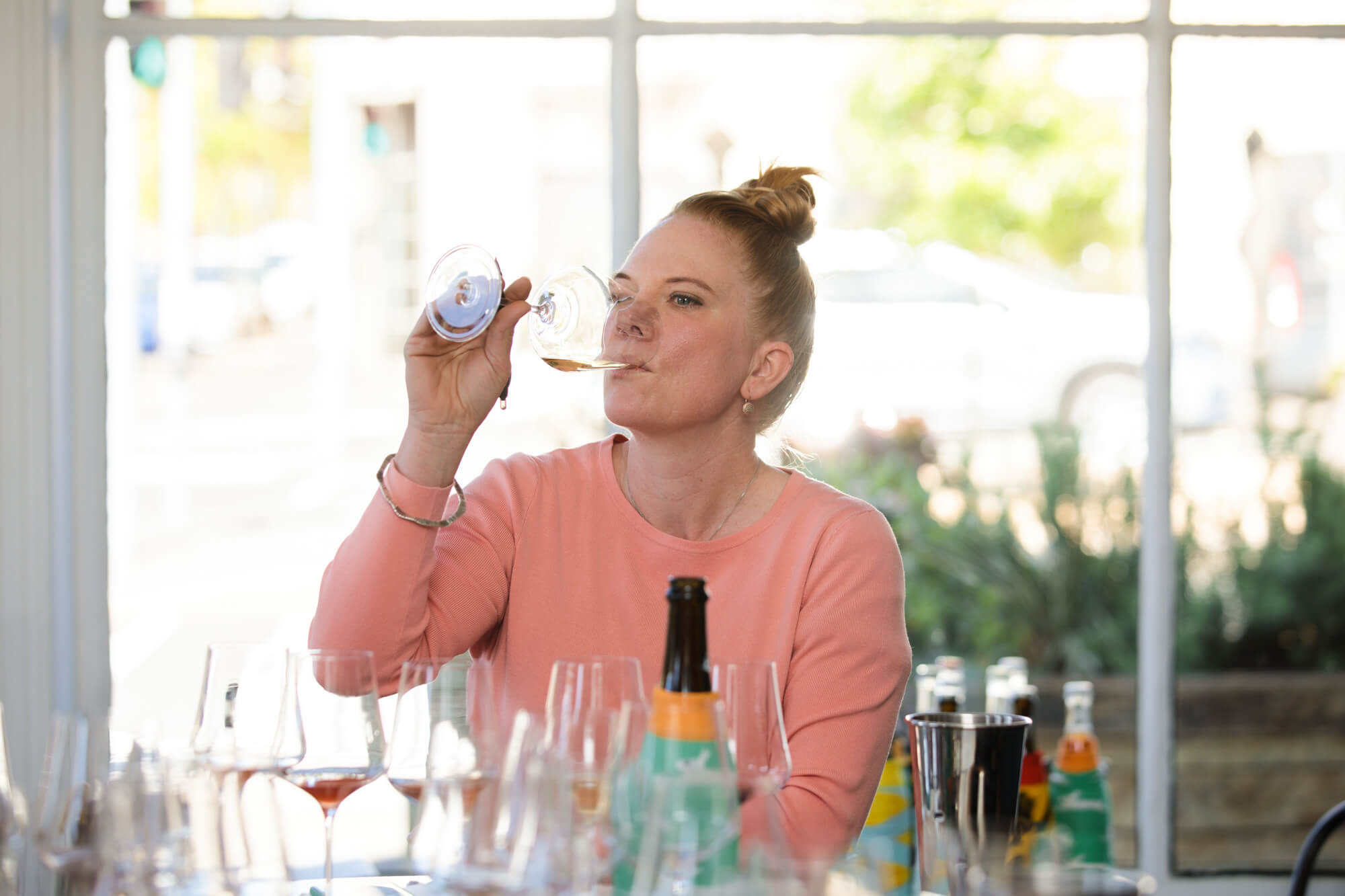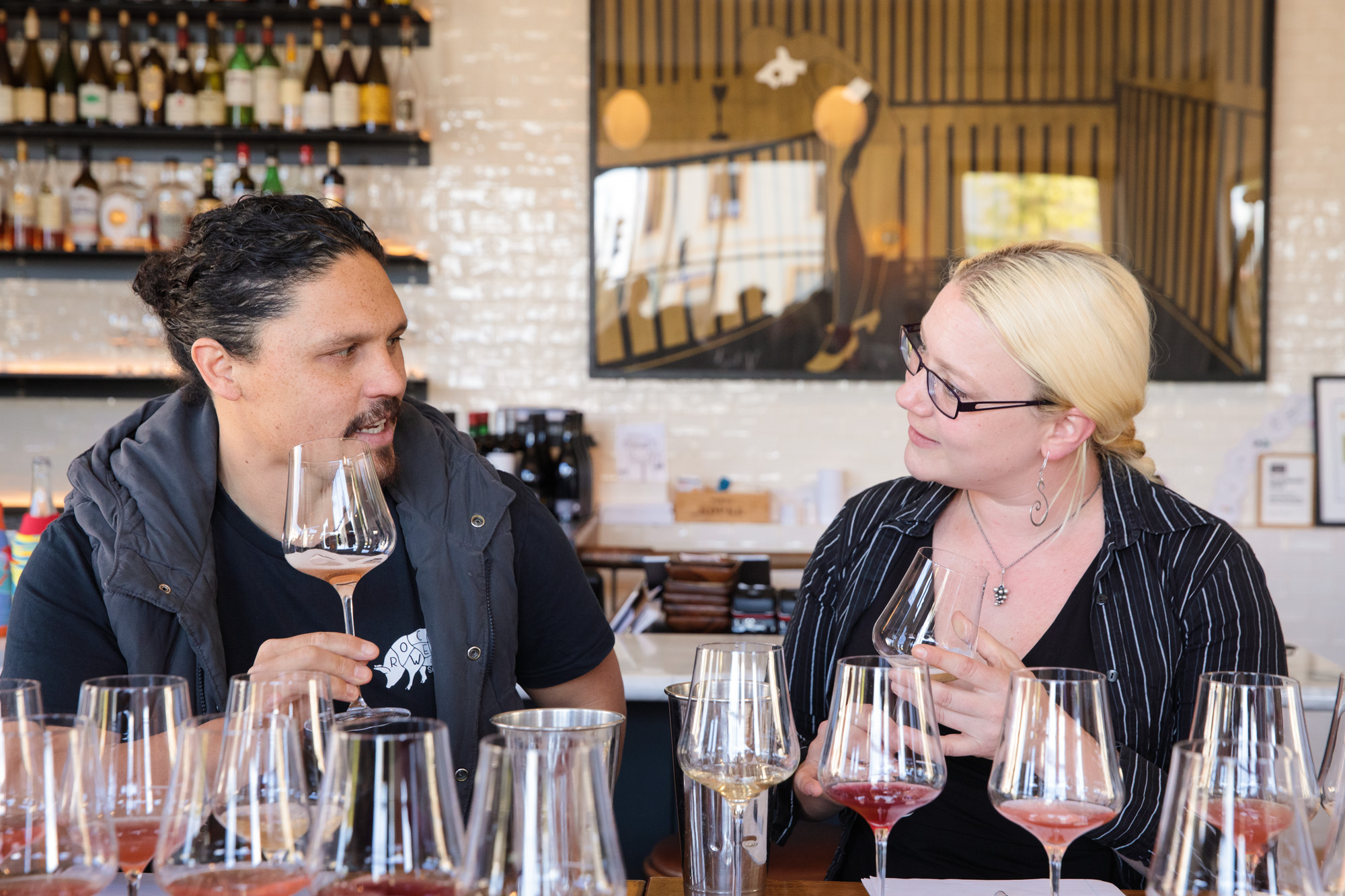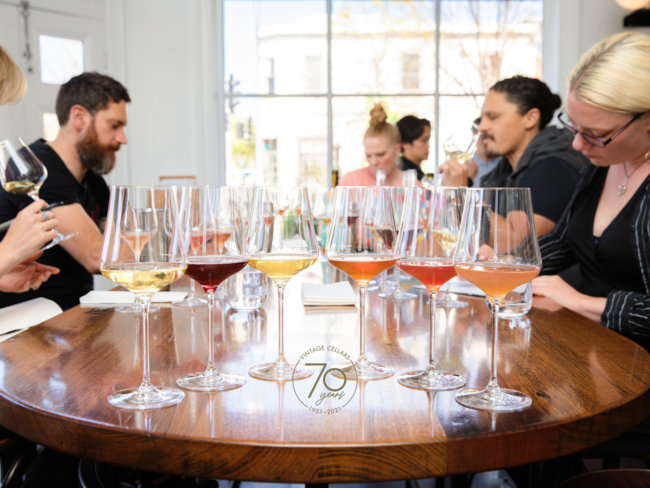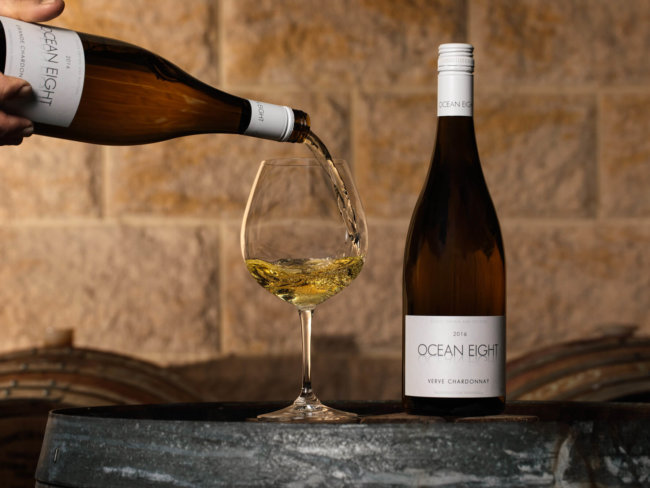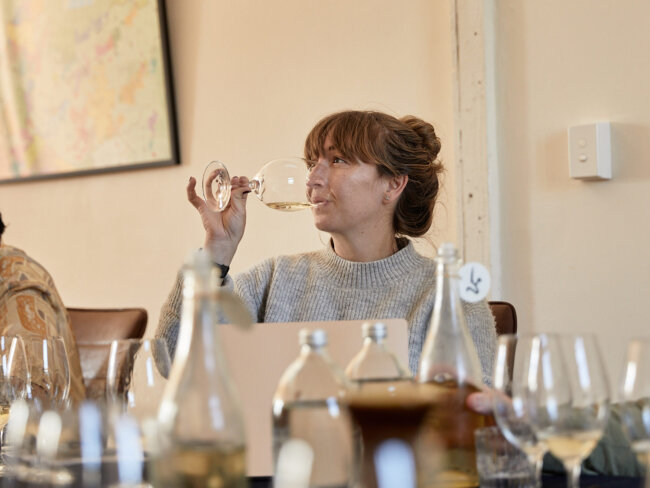While pét-nats may seem to be the province of the bright young things at the sharp end of the avant-garde, they are very much an homage to times past. The name of the underlying technique, méthode ancestrale, betrays that. But that’s pretty true of the new, or should we say newish (wines of a natural bent are more than a little entrenched), wave. Old methods. A return to roots, eschewing the sanitising corruption of technology. Tradition resuscitated and cast in a new light, spun nimbly by makers born to a different time, to different sensibilities. Everything old… as they say.
With no rules aside from the fundamental principle of finishing primary ferment in bottle. Some makers prefer the visual and flavour clarity that comes with disgorging (this is when all the sedimentary lees from the expired yeast cells are collected in the neck of the bottle, which is then opened to expel them, and then the bottles are topped with the same wine and resealed). While others opt for a very traditional, lo-fi approach, with the wine not disgorged, leaving a haze of lees in the bottle (think Coopers Sparkling). Some are released in the same year as harvest, while others slumber on their lees to build texture and complexity over months and even several years. So, any extensive tasting of pét-nats will never uncover some sort of universal truth, but rather be a celebration of the expansive diversity of the style.
While the method is ancient, the term pétillant naturel is not, being coined by some celebrated Loire Valley natural winemakers in the 1990s. So, the style is inextricably linked to the natural wine movement (check out Ryan Larkin’s piece on the subject to unpack exactly what that means). But before we go any deeper, what exactly is a pét-nat?
In French, pétillant naturel simply means ‘natural sparkling’. It is the simplest way to make sparkling wine, and before it was an established method, it would simply have been a frequent result of making and bottling wine. A quick winemaking 101 explains this.
Bubbles 101
Grapes are full of sugar and they have a natural coating of vineyard yeasts on their skins. The yeasts eat the sugars (fermentation) and produce alcohol and carbon dioxide as by-products. If you bottle the wine before the yeasts have finished their feast, you’ll end up with bubbles in the bottle from the residual ferment. You’ll need a pretty good seal to keep the wine in, which is why a crown seal (think beer bottles) is the typical closure these days (it’s also cheap, as are most local pét-nats – relatively speaking).
There would have been many unintentional pét-nats in the less rigorous early days of bottling, with plenty of exploding bottles and extruded closures, too. Controlling this process gives us the pét-nats we know today (which can still be quite volatile when opened – do this over a sink at home), though in Gaillac and Limoux, in Southern France, the style was refined many hundreds of years ago, well before Champagne, that most luxurious of sparklings, found its fizz. (Note that Champagne is made with fully fermented still wine that goes to bottle with added yeast and sugar to create the fizz – it’s an important distinction.)
![]()
Bryan Martin at Ravensworth opens a pét-nat
![]()
Pét-nats are prone to gushing upon opening. At Carlton Wine Room; photo by James Morgan.
The key here, too, is that you really don’t need to add sulphur to a pét-nat, as the CO2 protects the wine from oxidation. After all, those bubbles are trying to get out of the bottle, and there’s certainly no chance of any air making its way in, given the pressure. This makes pét-nats an ideal opportunity for natural winemakers to bottle wines with no additions at all, while a preventative dose of sulphur (in that it resists oxidation and helps control marring microbiological activity) would typically be needed for a table wine. Without that sulphur, the wine can still develop some ‘funky’ characters, which pét-nat aficionados often see as complexity, rather than fault.
Pét-nats in Australia
While ancient, the style is a fairly new one for this country, and it was partly introduced as necessity-driven improvisation, with Gilles Lapalus making his first ‘Ancestrale’ at Sutton Grange from the sodden 2011 vintage. Around the same time, James Erskine of Jauma was dabbling with pét-nats from his base in the Adelaide Hills, and his neighbours in the cradle of Australian natural wine were soon to catch on. Lapallus has since taken the inspiration to make wines under his Bertrand Bespoke imprint, while Melanie Chester continues the tradition at Sutton Grange.
Today, there is an explosion (pun intended) of bottles, with no rules aside from the fundamental principle of finishing primary ferment in bottle. Some makers prefer the visual and flavour clarity that comes with disgorging (this is when all the sedimentary lees from the expired yeast cells are collected in the neck of the bottle, which is then opened to expel them, and then the bottles are topped with the same wine and resealed). While others opt for a very traditional, lo-fi approach, with the wine not disgorged, leaving a haze of lees in the bottle (think Coopers Sparkling). Some are released in the same year as harvest, while others slumber on their lees to build texture and complexity over months and even several years. So, any extensive tasting of pét-nats will never uncover some sort of universal truth, but rather be a celebration of the expansive diversity of the style. Good enough reason for a deep dive, we think.
Johns found that while the varietal mix accounted for a broad range of flavours, there was nonetheless a theme, which she found “nostalgic,” recalling (positively) confectionary characters from her childhood, such as “cotton candy, musk, toffee apple bars, red liquorice.” She also felt that across the line-up many of the wines reminded her of “soft drinks, soft drinks for adults obviously,” and wondered whether this suggestion, matched with an adult-appropriate level of dryness lent them some of their appeal.
As always, the panel was made up of six of the country’s finest tasters, makers and thinkers, with a brief to find the wines that compelled the most. This was not an exercise in technical perfection or to champion one style over another, nor was it a search for profundity. Rather, the aim was to find wines of interest and character. The below notes are comprised of the wines that made a final list of six from each of the tasters.
Our panel was made up of: Peta Baverstock, owner/winemaker Cuvée-Co; Ryan Larkin, owner/director Larkin Imports; Natasha Johns DipWSET, Brand Manager Shaw + Smith and Tolpuddle; Abby Moret DipWSET, owner of Atlas Vinifera; Andy Joy owner/manager of The Carlton Wine Room; Wiremu Andrews, sommelier at Point Leo Estate and director of Dearth of a Salesman. All wines were tasted blind.
![]()
Blind tasting pét-nats at Carlton Wine Room. Photo by James Morgan.
The overview
Given that pét-nat as a category is technique based, there is an incredible range of expressions, with all grape varieties being fair game, either solo or as part of a blend. So, from pale white-wine hues to golden tones to pink blushes to quite intense and somewhat lurid reds, the visual palette was the first signpost that this was not going to be a tasting of like-for-like comparisons.
It’s also worth considering that there’s not really a lot of opportunity to build complexity into a pét-nat before the wine is bottled; extended time on skins, or post-ferment maturation time in a barrel, egg, amphora or the like is mostly out of the equation. Technically, the fermentation can be arrested and then restarted when going to bottle, which means some winemaking tinkering is possible, but this is typically outside of the spirit of pét-nats, except to clarify the wine. However, the tasting revealed plenty of complexity, from varietal mix to extended time on lees in bottle to Sherry-like aldehyde to some wilder characters that mostly enhanced rather than detracted.
![]()
The pét-nat kaleidoscope. At Carlton Wine Room; photo by James Morgan.
“A really eye-opening tasting of a style of wine that rarely gets examined comparatively. It’s fair to say that there was a veritable fruit-salad of wines, some leaning closer towards a classic sparkling structure of apple-like acids, toasty autolytic notes from extended lees contact and gentle, caressing mousse while intense, in-your-face sparklers turned on the charm with abundant fruits and a carefree structure meant for frivolity,” Andrews commented.
Joy noted that some of the less technically pure styles were perhaps the ones that knit most into the drinking demographic, with the wines that showed less ‘funk’ sitting somewhat outside of expectations. And while this was in some senses a commercial observation, he also personally found favour with some wines that were technically imperfect but ultimately engaging, and not just in spite of it, but perhaps for it.
Baverstock found that while some less-clean characters didn’t mar some wines, that the more overtly funky wines detracted from their appeal. “Pét-nat is a youthful drink-now style,” she reflected, finding a couple of the wines looking a little tired and rustic. That topic of purity or otherwise came up several times. “I found that while some wines were faulty, especially with the presence of VA and brett, this was not necessarily a detraction from the finished product except in some extreme cases,” remarked Moret.
Baverstock also noted the dryness of the wines. Some showed a little residual sweetness, but the overwhelming majority didn’t. “What took me with this whole tasting was how many were dry, which I was impressed by,” she reflected. “But some of that dryness became a bit too austere,” she added, saying that without a little sugar for balance they were very much food styles, needing some fat or cream to balance the acidity.
![]()
Peta Baverstock and Wiremu Andrews at Carlton Wine Room. Photo by James Morgan.
Andrews found favour across the spectrum, both with wines more in a Champagne mould, with bready autolytic characters, as well as those that had a more rustic feel. He praised wines that looked varietal with extended lees character, as well as some that walked a wilder path, obscuring primary fruit character.
Moret found considerable engagement with wines that spoke of variety. “Overall, the wines I liked the most seemed to be the ones that had notes of their varietal makeup,” she said. “Going forward I’d love to see more varietal wines – these really appealed to me, and have a great potential to reach a new demographic of sparkling wine consumers.”
Johns found that while the varietal mix accounted for a broad range of flavours, there was nonetheless a theme, which she found “nostalgic,” recalling (positively) confectionary characters from her childhood, such as “cotton candy, musk, toffee apple bars, red liquorice.” She also felt that across the line-up many of the wines reminded her of “soft drinks, soft drinks for adults obviously,” and wondered whether this suggestion, matched with an adult-appropriate level of dryness lent them some of their appeal.
Larkin, who imports several French examples, commented that the quality of the local wines had increased considerably, with the earlier examples in this country being of greatly varying quality. “I think a lot of them are quite impressive, and a lot cheaper [than imported examples],” he said. However, he also pointed out that there is a complexity to the best French versions, which he partially attributes to the yeasts in the old cellars. “You can smell the Loire Valley cellars; there’s old yeast in there,” he remarked.
![]()
Ryan Larkin and Natasha Johns. At Carlton Wine Room; photo by James Morgan.
Overall, while pét-nats share a production method, they are not easily boxed in. They’re bubbly, some effusively so, but the tasting revealed a panorama of expressions, from the frivolous to those that demanded food and a little more attention. And neither triumphed over the other, with credit accorded across the spectrum from the tasting panel.
The Number One Picks
These are the number one picks from each of the panellists, with supplementary notes from other panellists if they featured in their top-six lists.
![]()
2017 Architects of Wine Riesling Nebbiolo Pétillant Naturel, Adelaide Hills $32
This was the top wine for both Moret and Joy, with Johns and Andrews also including it in their top-six lists. “Really vinous. Notes of leather, oranges, amaro, old books, spice, tobacco, apple. Great texture, some rusticity which adds to the overall charm of the wine. Reminds me of an aged wine with bubbles – really sexy wine,” wrote Moret. “Rusty saignée appearance, toffee and toast aromatics, tight palate with good structure and sherry-like complexity, well balanced and exceptionally complex,” remarked Joy. Johns saw “bruised apples, ale, honey, white flowers, VA, citrus peel – lemon and orange,” with Andrews picking up “intense orange blossom, mineral, slight kero note on the nose.” He also remarked that it “smells like Ruggabellus made a pét-nat,” while Johns found it “Very savoury and phenolic but not in a mean way. Super interesting and persistent on the palate.” Andrews added that it was very much a wine that needs food, and that he “would definitely decant.”
![]() 2019 Frankly This Wine Was Made by Bob Rosé, Orange/Mudgee $33
2019 Frankly This Wine Was Made by Bob Rosé, Orange/Mudgee $33
Rated by three of the panel, this was also Johns’ top pick. “Delicate red fruits on the nose, currants and strawberries and cream but with some fascinating Chinese five spice notes. Juicy red apples and nashi pears on the palate with hints of raspberry and some liquorice all wrapped up in a spine of tingly acid and some chewy phenolics. Soft and pretty but also interesting and textural. Yum,” she wrote. “A curious nose of winter red fruits, rhubarb and marzipan with grip, texture and full of flavour to boot. A great concentration of effervescence and fizzy bubbles on the palate. Grippy tannins, weighty and creamy – very satisfying,” said Baverstock, while Joy found it “peachy and opulent, with full mouthfeel, balanced and pleasant.”
![]() 2016 Friends of Punch ‘Rurale’ Chardonnay, Yarra Valley $32
2016 Friends of Punch ‘Rurale’ Chardonnay, Yarra Valley $32
Also featured by three tasters, this was Andrews’ top selection. “My number one wine was the first wine tasted of the thirty. A classic straw hue with a gentle, fine bead. There was a focused, mineral-laden undertone and a creamy, stone fruit inflected fruit characteristic that screamed chardonnay. A honey/nougat and brioche aroma hinted at an extended time on lees (20-months in fact) and a tip of the cap towards Champagne. Ripe yet still fresh. Structured and delicious,” he wrote. Moret and Baverstock also noted the similarity with Champagne. “Smells traditional, with time spent on lees. Toasty, yeasty, brioche, apples, a touch aggressive mousse, nice overall texture and finish. Nice level of depth and complexity, vibrant acid, touches of marzipan/nuts,” wrote Moret. “More of a traditional style of sparkling with long lees ageing evident. Honey, toast, rich with a creamy bubble, long acid and a generous dose of nutty aldehyde,” chimed in Baverstock.
![]() 2019 Express Winemakers ‘Foamo’, Great Southern $32
2019 Express Winemakers ‘Foamo’, Great Southern $32
This was Larkin’s top wine of the tasting: “Nice peach/orange colour. That nose is so good and expressive! Peach and strawberry heaven. In the mouth the wine is dry and fresh. Crispy watermelon and guava flavours. Juicy mandarin too. Yum. Acidity is high-ish, but in check. Lingers. Very dry, grippy finish. To be picky, it doesn’t feel ultimately harmonious (maybe a few varieties?), but I don’t mind, as overall it is very enjoyable. Mouth-watering, with a touch of strawberry coming through. This would be great to drink on its own or with food. Nice and light, fragrant and easy.”
![]() 2019 Ravensworth Riesling Ancestral, Canberra District $38
2019 Ravensworth Riesling Ancestral, Canberra District $38
This was Baverstock’s pick of the tasting: “Awestruck by the ‘completeness’ of this wine. Seamless balance of crisp acid with just enough fruit ripeness. Fruit driven with fragrant tart pineapple flavours with great texture and palate weight – mouth filling. A well-made, turbid example of pét-nat that had ‘smash-ability’!”
The Consensus Picks
These were all in the top six lists, receiving cross support from the tasters, though none were nominated as their wine of the day.
![]() 2019 Konpira Maru ‘Mt Midoriyama’ Pét-Nat, King & Alpine Valleys $29
2019 Konpira Maru ‘Mt Midoriyama’ Pét-Nat, King & Alpine Valleys $29
While not topping any of the panellists’ lists, this had plenty of support, with five tasters logging it in their top six. “Boiled lollies, hard rock candy, apple skins, caramel/toffee, sweet strawberries, nice acidity and texture, a good amount of complexity of flavour, nicely candied without much residual or cloying sweetness,” wrote Moret. John’s also positively noted confectionary characters. “So nostalgic on the nose; cotton candy, musk, toffee apple bars, red liquorice, orange; super-aldehydic and quite potent. Pillowy confected red fruits on the palate, juicy and well defined with some funk and splice-icy-pole acid. Intoxicating and undeniably delicious.” As did Larkin: “Slightly candy apple nose, and very lively. Fresh and light, very dry. Sweet flavours, but not as sweet as the nose suggests. Redskin lollies and cherries. And that dry finish that lingers. A touch savoury in background too, to give it extra interest. Overall, I feel like the candied note on the nose will subdue with a bit more bottle time, as I’ve seen that happen with some of the pét-nats I’ve imported. I get the same feeling with this. Not perfect, but lots of fun.” Joy found it “very well crafted overall,” while Andrews called it “Opulent and confected with stewed, salted strawberries and fresh lawn cuttings to buckle the wine in. Looks like classy rosé that’s been gassed up for good times.”
![]() 2018 Fairbank Ancestrale Sparkling Rosé, Central Victoria $35
2018 Fairbank Ancestrale Sparkling Rosé, Central Victoria $35
Larkin, Baverstock and Andrews all logged this in their top-six lists. “Peach colour. Love that nose, so gentle and dreamy. Great restraint on the aromats, and natural fruit, no candy. Maybe a bit of yeasty/bready notes blocking the fruit slightly initially but only just. Very restrained on the palate too. Light, delicate and fluffy. Very easy drinking. Not a flavour bomb overload which is nice. Gentle apricot, peach and strawberry flavours, with hints of florals. Smooth and effortless. Cruisy as. A very nice park wine. Could quite happily drink this in the sun at a picnic. Nice and easy, and very well balanced overall,” wrote Larkin. “An interesting peach colour with heavy yeast turbidity adding to textural overtones. Underneath crunchy red apple, dried petals and a lifted perfume throughout. Showed layers of interest and a great rosé style of pét-nat,” noted Baverstock, while Andrews was concise but complimentary: “Salted peach. Savoury and compact. Tannins add interest and shape. Nice phenolics. Brooding and serious.”
![]() 2019 Bertrand Bespoke ‘L’Ecume du Jour’ Ancestrale, Central Victoria $37
2019 Bertrand Bespoke ‘L’Ecume du Jour’ Ancestrale, Central Victoria $37
This featured in the lists of Baverstock, Andrews and Moret. “Stewed pears, cinnamon and baking spices, rockmelon/cantaloupe, softly petillant palate, splashed with roses, pears, spices, gentle and no faults,” wrote Moret. Baverstock called this, “A summer days’ drinking pét-nat.” She continued, “Light straw in colour, with a fragrant fruity nose. It was all about the texture in this wine with an austere finish making it perfect for refreshing the palate time and time again.” Andrews noted, “Pear drops and white flowers dominate the nose and a slight grapey note is vaguely reminiscent of glera (in a good way). Peaches and pears vie for dominance on the palate and phenolic grip keeps the fleshy mid-palate honest.”
![]() 2018 I’ll Fly Away Riesling Pétillant Naturel, Eden Valley $32
2018 I’ll Fly Away Riesling Pétillant Naturel, Eden Valley $32
Joy included this is his top six: “Golden blush to colour, riesling-like aromatic that is clear and present, slightly toasty with hints of atins and aldehyde, pronounced and clean acidity, supporting strength of fruit throughout palate.” As did Larkin. “Yellow colour, quite vibrant. Very aromatic. Must be riesling. Blossoms, apple, lemon, white stone fruits. Expressive aromas, but not too much. Love the mousse as it’s light and fluffy. Delicate lemon, green apple crunch, not too sour, nicely balanced. A touch of honey but not sweet. Some hint of mineral or maybe something metallic. I like the lingering acidity on this. Very long in the mouth. Couldn’t drink heaps, but very well made, and a great food wine. Very fresh and bright. I struggled because normally I’m not a massive fan of riesling but I really liked this,” he wrote.
![]() 2019 The Other Right ‘Bright Young Thing’, Adelaide Hills $34
2019 The Other Right ‘Bright Young Thing’, Adelaide Hills $34
Finding favour with Johns and Joy, the latter wrote: “Slight rusty blush in appearance. Complex aromatics with aldehyde and bread, balanced palate with good fruit definition.” Johns found it “Quite fruit pure and pretty on the nose,” with “red berries, cherries, raspberries anise and some herbal elements: black tea,” while she found “An absolute explosion of fruit on the palate – like biting into a tart ripe plum – some lovely tannin here that creates quite a bit of grip but with that generosity of fruit the texture is pretty beguiling. Bright acid, very moreish.”
![]() 2019 Delinquente ‘Weeping Juan’ Pet Nat, Riverland $25
2019 Delinquente ‘Weeping Juan’ Pet Nat, Riverland $25
This was selected in the top-six lists of both Johns and Moret. “Red apple, raspberry candy, redskins, green apple, soft palate, nice fuzzy texture, soft and easy drinking,” wrote Moret. “Peach, red apples and red currants with strawberries and blossom. Tart and juicy red and orchard fruits but with some really interesting textural elements, pithiness and phenolic grip. Soft, supple, almost voluptuous fruit but some spritely acid on the finish and that chew. Super interesting,” wrote Johns.
![]() 2019 Gemtree Pet Nat, McLaren Vale $35
2019 Gemtree Pet Nat, McLaren Vale $35
This found favour with both Moret and Larkin. “Boiled lollies, toffee apple, heavily confected, nice acid, good texture, soft and a touch sweet. Overall nicely balanced, quite clean,” she wrote. “Light pink, salmon colour. Lemon and unripe strawberry nose. Gently pretty. Nice fluffy mousse, gentle texture. Everything is very well integrated. Subtle flavours. This is a bit more classy than the rest. Lemon, stony, fresh, crisp. Love the acidity, which is balanced and long. If I was to be picky, I could say this is nice but maybe too perfect and lacks something extra. But in saying that it is very well put together and is unique compared to everything else we’ve tasted – it is much more polished. Very easy to drink, nice delicate flavours. Good for those that like it clean and reliable, rather than a bit loose and funky,” reflected Larkin.
The Other Top Picks
These wines featured in one of the panellists’ top six, but they were not necessarily the lowest ranked on their individual lists. We’ll let their words do the talking.
![]() 2018 Cullen ‘Rose Moon’, Margaret River $50
2018 Cullen ‘Rose Moon’, Margaret River $50
Joy: “Bright and vibrant, cloudy pink in appearance, slight volatility to aromatics, also showing through on palate, creaminess to acidity, slight aldehydic notes, good representation of style, would speak well to demographic.”
![]() 2019 La Violetta ‘Spunk Nat’, Mount Barker/Frankland River $37
2019 La Violetta ‘Spunk Nat’, Mount Barker/Frankland River $37
Larkin: “Electric pink/blood orange colour, quite clear. I love the nose because this is what pét-nats are about – something interesting and fun – not perfect, but fun. Tropical fruits, guava, watermelon, strawberry. Dry, fresh, crisp. Light flavours and delicate delivery. A subtle herb in breeze notes. Hard to guess what it is which makes it more interesting. Beautiful citrus acidity and ends with a dry savoury finish. A touch of candy in the background, but I think the wine is young and this will integrate. Very summery. Also one of the best. Watermelon. Flavours are subtle. Maybe not the perfect finish, but I still like it. Would like to see again in a few months.”
![]() 2019 Commune of Buttons ‘Fleur Gris’, Adelaide Hills $22
2019 Commune of Buttons ‘Fleur Gris’, Adelaide Hills $22
Andrews: “My second favourite wine played with light and shade in an emphatic way. Pale peach with a luminous core was its colour palette. Understated. Both confected while remaining subtle. Lovely fruit weight as well as a beautiful, savoury nuance.”
![]() 2016 Ravensworth Gamay Ancestral, Canberra District $38
2016 Ravensworth Gamay Ancestral, Canberra District $38
Johns: “Very varietal, like pinot noir or Gamay – vinous. Red berries, strawberries, red plums, some dried floral notes, quite perfumed with a soft, moussey palate. Finish is a bit short, but clearly its grape variety, and almost table wine like in its appeal.”
![]() 2019 Ngeringa ‘Uncultured’ Pet Nat, Adelaide Hills $30
2019 Ngeringa ‘Uncultured’ Pet Nat, Adelaide Hills $30
Baverstock: “A playful rose-coloured drink with a boost of red fruits teetering on floral, with fruit salad aromatics. Good length throughout the palate showing a great balance. A Lighter, overall pretty little number, maybe lower in alcohol? Turbid.”
The Panel
![]()
Andrew Joy
Andy Joy has played an important role in the development of wine bar culture in Melbourne, being the founding wine buyer and manager of Cumulus Up, as well as the manager at Andrew McConnell’s other wine institution, Marion, where he was showered with national accolades for his efforts. Striking out on his own (well, with Travis Howe and chef John Paul Twomey), Joy re-launched The Carlton Wine Room to instant and sustained success. He also makes wine with his cousin Leighton Joy under the Little Ra Ra imprint, as well as under the family label from their Pyren Vineyard, in Victoria’s Pyrenees.
![]()
Peta Baverstock
Peta Baverstock gained a Bachelor of Agricultural Science (Oenology) from Adelaide University, graduating in 2000. She worked under the legendary Ed Carr, Chief Sparkling Winemaker for Constellation Wines (now Accolade), for seven years before becoming a freelance consultant winemaker, specialising in sparkling wine, under the Cuvée Consult banner. She is a four-time finalist in the notoriously competitive Vin de Champagne Awards, and has been making wine under her Cuvée-Co label since 2018.
![]()
Ryan Larkin
Ryan Larkin is a specialist importer, wholesaler and online retailer of French natural wines. Often classed as an obsessive wine nerd, he spends all of his money on wine because you can’t drink a house. Apart from travelling to France twice a year to work directly with natural winemakers, he also scours the globe for unicorns and snow leopards, and is known for opening these rarities with other like-minded aficionados. You can find him on Instagram at @r_larkin or at larkinimports.com.au.
Abby Moret has been working in the retail wine industry since she was 18, including working in London for Majestic Wine, gaining her WSET Level 3 Certificate while there. Upon her return to Australia, she became the Promotional Manager of Vintage Cellars, curating the wines and stories in Cellar Press, before moving into buying and product development for the national chains. After gaining her WSET Diploma, Abby founded Atlas Vinifera in 2017, an independent, boutique wine bar and wine store in Richmond which specialises in small-batch, interesting, hand-crafted and cult wines from all over the world.
![]()
Wiremu Andrews and Abby Moret
Wiremu Andrews is the director of Dearth of a Salesman, representing small artisan wineries across Victoria, as well as working as a consultant, educator and sommelier for hire. He currently works on the wine team as a sommelier at the much-lauded Pt. Leo Estate.
![]()
Natasha Johns
Natasha Johns has worked in the wine industry for over 15 years, primarily in sales and marketing roles. She is a WSET Diploma holder, and is currently the Brand Manager for iconic labels Shaw + Smith and Tolpuddle, as well as The Other Wine Co.
How the tasting was conducted
All wines were covered with socks (thanks to our friends at Sammi Icon), completely masking any branded labelling. The wines were presented with no particular order to the wines. Once the initial tasting was completed, the panel re-tasted as they saw fit to confirm or recalibrate their first impressions, and to give those wines tasted first a chance to be properly compared to those tasted later. The identity of the wines was revealed after the panellists had disclosed their opinions.
![]()

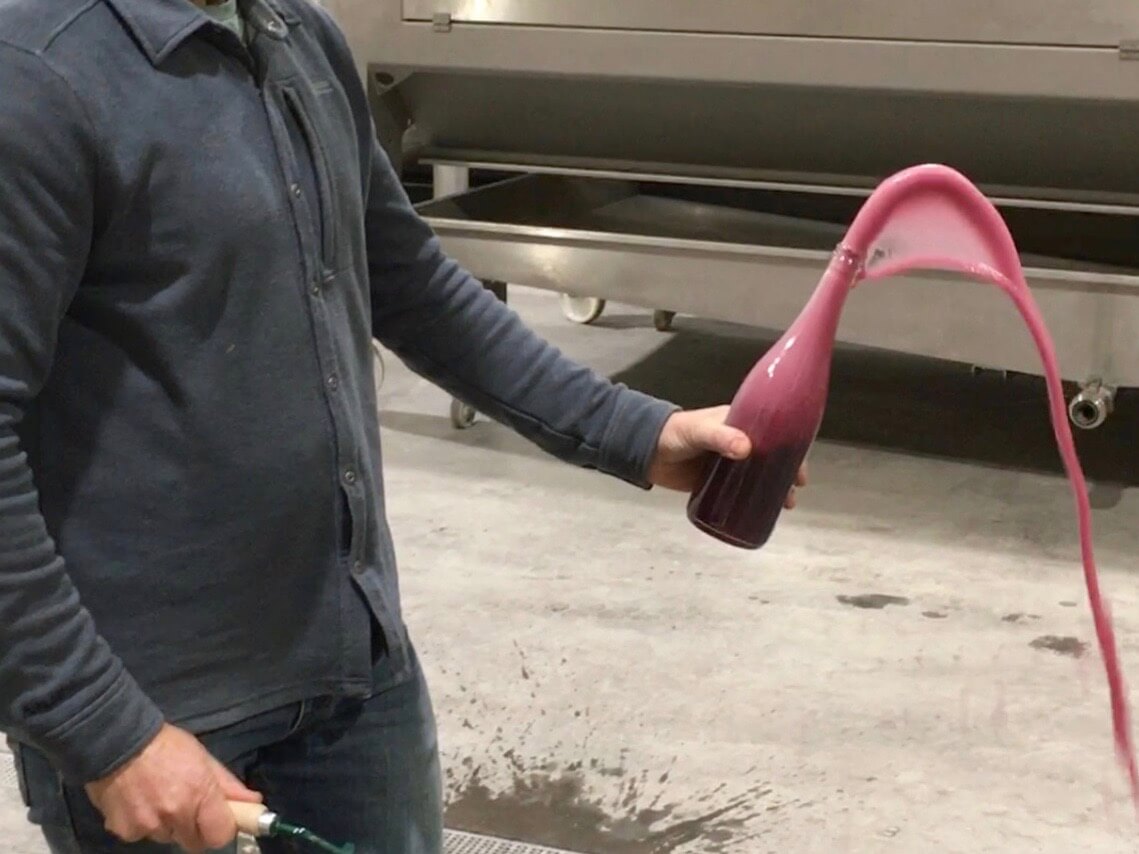

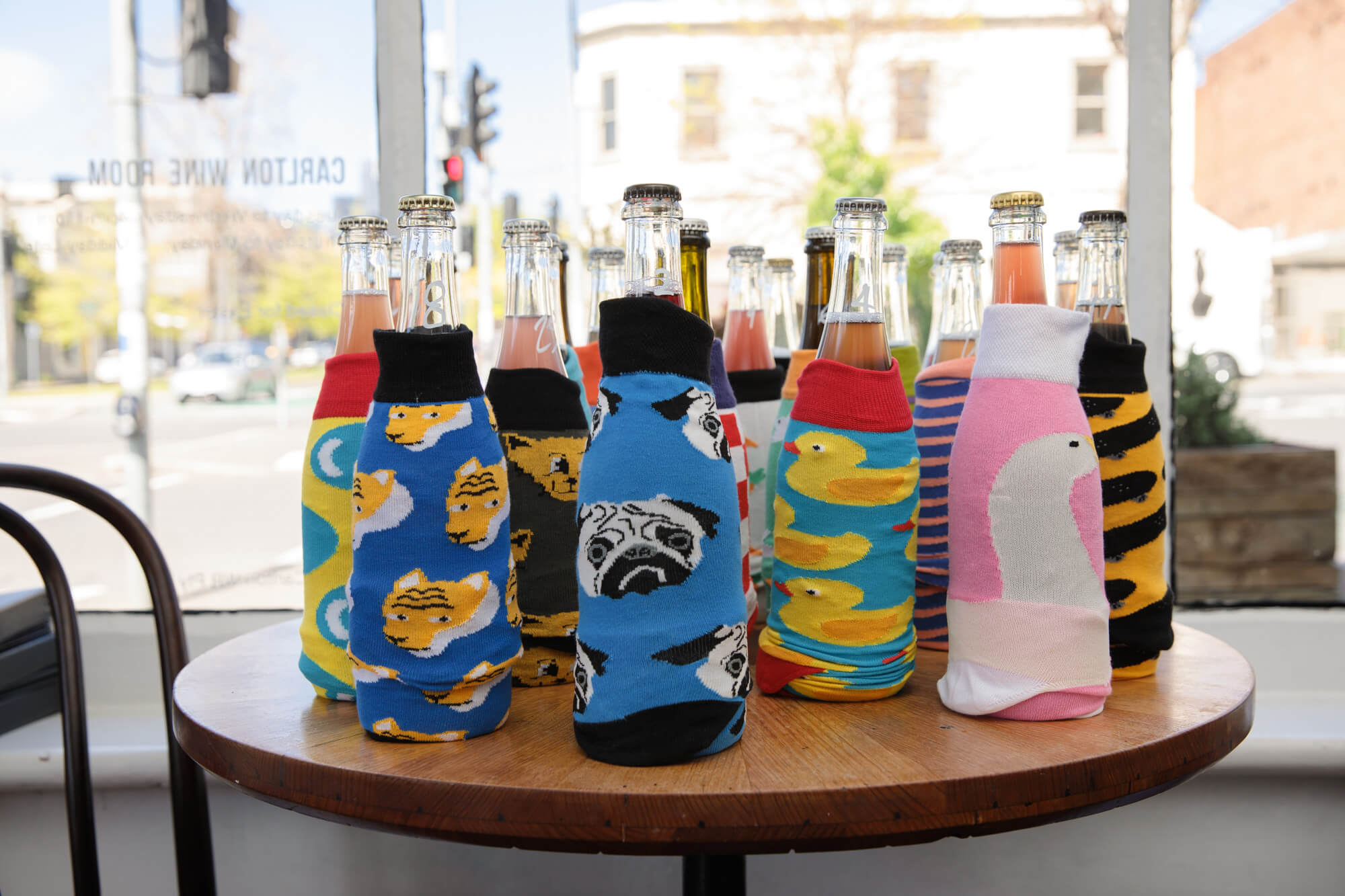


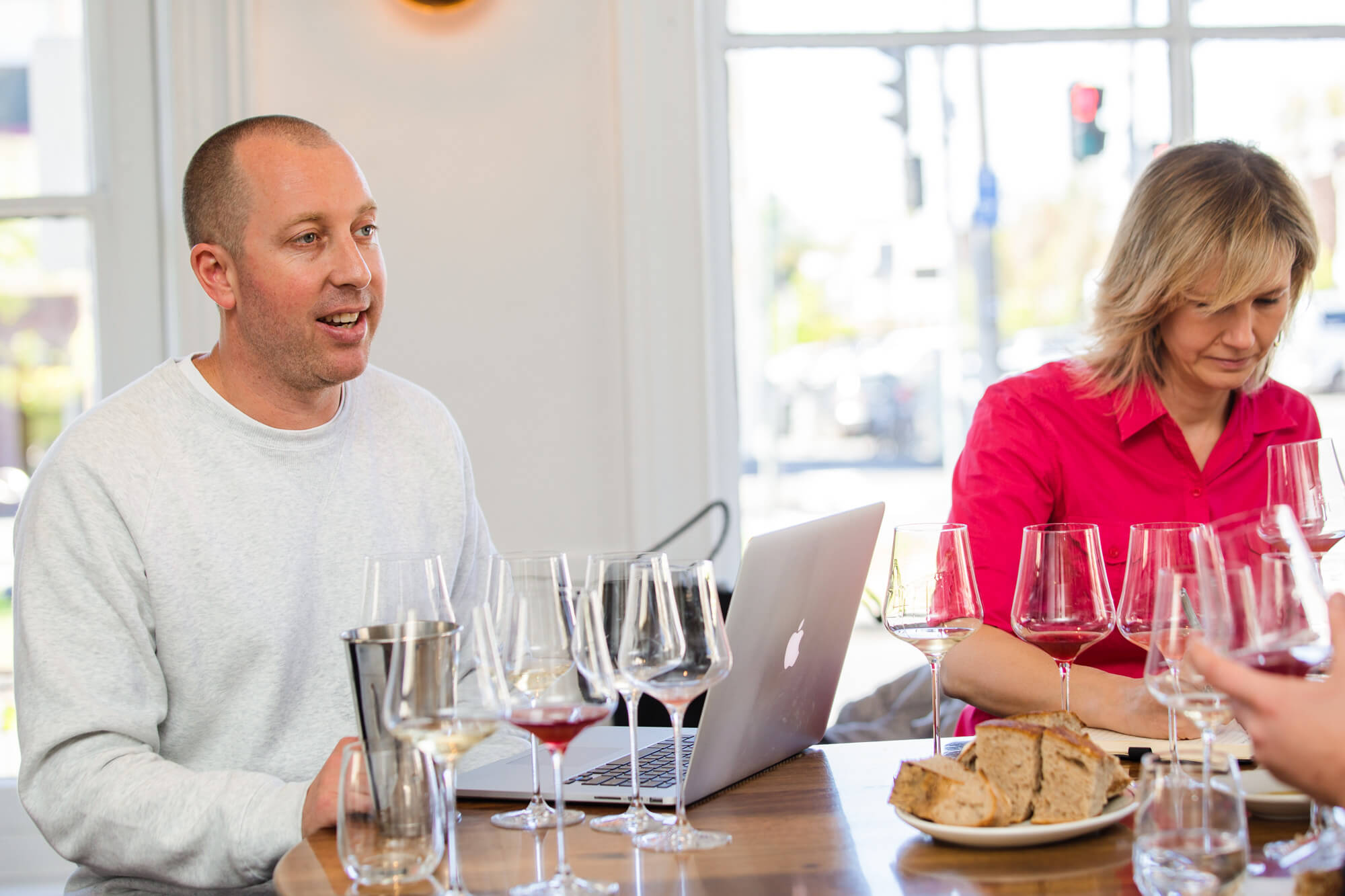

 2019 Frankly This Wine Was Made by Bob Rosé, Orange/Mudgee $33
2019 Frankly This Wine Was Made by Bob Rosé, Orange/Mudgee $33 2016 Friends of Punch ‘Rurale’ Chardonnay,
2016 Friends of Punch ‘Rurale’ Chardonnay,  2019 Express Winemakers ‘Foamo’, Great Southern $32
2019 Express Winemakers ‘Foamo’, Great Southern $32 2019 Ravensworth Riesling Ancestral, Canberra District $38
2019 Ravensworth Riesling Ancestral, Canberra District $38 2019 Konpira Maru ‘Mt Midoriyama’ Pét-Nat, King & Alpine Valleys $29
2019 Konpira Maru ‘Mt Midoriyama’ Pét-Nat, King & Alpine Valleys $29 2018 Fairbank Ancestrale Sparkling Rosé, Central Victoria $35
2018 Fairbank Ancestrale Sparkling Rosé, Central Victoria $35 2019 Bertrand Bespoke ‘L’Ecume du Jour’ Ancestrale, Central Victoria $37
2019 Bertrand Bespoke ‘L’Ecume du Jour’ Ancestrale, Central Victoria $37 2018 I’ll Fly Away Riesling Pétillant Naturel, Eden Valley $32
2018 I’ll Fly Away Riesling Pétillant Naturel, Eden Valley $32 2019 The Other Right ‘Bright Young Thing’, Adelaide Hills $34
2019 The Other Right ‘Bright Young Thing’, Adelaide Hills $34 2019 Delinquente ‘Weeping Juan’ Pet Nat, Riverland $25
2019 Delinquente ‘Weeping Juan’ Pet Nat, Riverland $25 2019 Gemtree Pet Nat, McLaren Vale $35
2019 Gemtree Pet Nat, McLaren Vale $35 2018 Cullen ‘Rose Moon’, Margaret River $50
2018 Cullen ‘Rose Moon’, Margaret River $50 2019 La Violetta ‘Spunk Nat’, Mount Barker/Frankland River $37
2019 La Violetta ‘Spunk Nat’, Mount Barker/Frankland River $37 2019 Commune of Buttons ‘Fleur Gris’, Adelaide Hills $22
2019 Commune of Buttons ‘Fleur Gris’, Adelaide Hills $22 2016 Ravensworth Gamay Ancestral, Canberra District $38
2016 Ravensworth Gamay Ancestral, Canberra District $38 2019 Ngeringa ‘Uncultured’ Pet Nat, Adelaide Hills $30
2019 Ngeringa ‘Uncultured’ Pet Nat, Adelaide Hills $30
